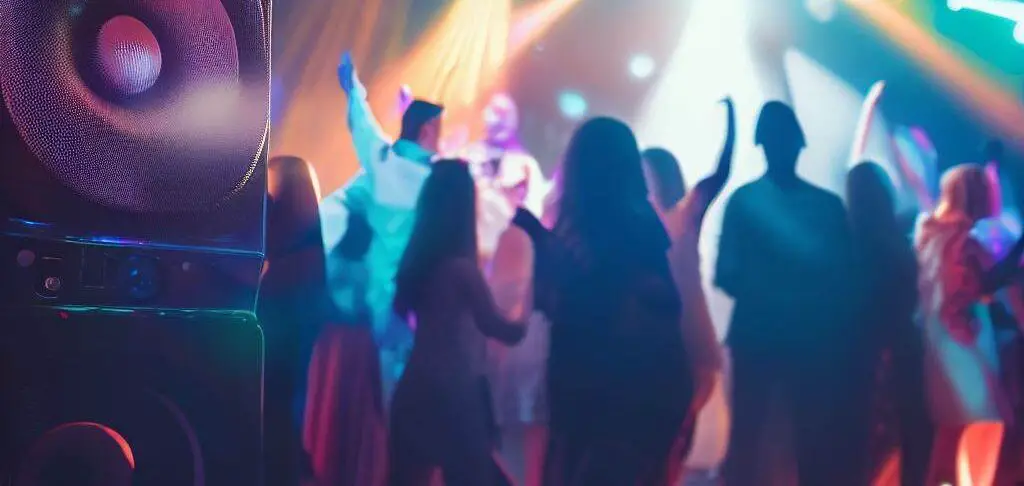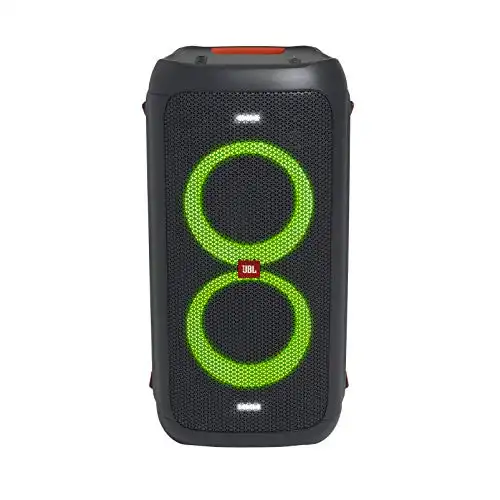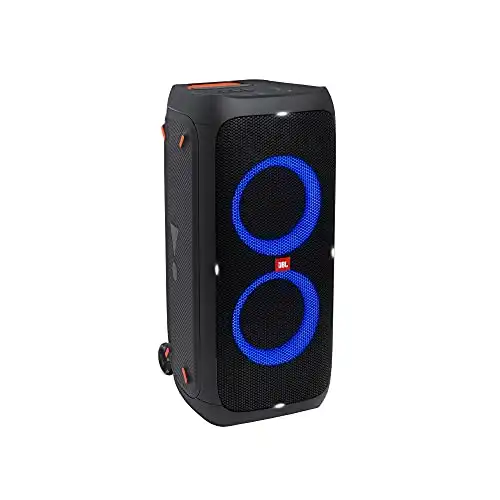Summary
All of the speakers discussed here — the JBL PartyBox 100, 200, 300, 310, and 1000 — are excellent party speakers. If you want a portable(-ish) party speaker that provides lots of volume and bass while also featuring a light show, JBL PartyBox speakers are one of the best options available.
PartyBox 100 is the best value of the lineup, and cheaper than the others.
PartyBox 1000, at the other end of the spectrum, is the top performer but also has the largest price tag.
The middle of the lineup features the PartyBox 200, 300, and 310, which are all similar in performance with some distinctive features. PartyBox 200 lacks a built-in battery, so it requires a constant power source. PartyBox 300 is basically the battery-powered version of the 200, with similar performance. PartyBox 310 is the updated version of these speakers, and is app-compatible with better controls. The 310 also adds wheels for increased portability, an IPX4 splashproof rating, and has slightly higher sound quality.
If you like booming bass and don’t mind the heavy weight (all PartyBox speakers weigh 20+ pounds), any of these speakers is a great purchase.
~~~ JBL PartyBox 100: Check Price ~~~
~~~ JBL PartyBox 200: Check Price ~~~
~~~ JBL PartyBox 300: Check Price ~~~
~~~ JBL PartyBox 310: Check Price ~~~
~~~ JBL PartyBox 1000: Check Price ~~~
Quick Buying Guide
PartyBox 100 vs. 200 vs. 300 vs. 310 vs. 1000
The easiest way to decide is based on budget and whether or not you need a speaker with a battery.
- The PartyBox 100, 300, and 310 all have a built-in rechargeable battery. PartyBox 200 and 1000 have no built-in battery, and require a constant power source in order to function.
- PartyBox 1000 retails for more than $1,000. PartyBox 200, 300, and 310 usually sell for about half the price of PartyBox 1000. And PartyBox 100 is the only speaker listed that can generally be found for $300 or less.
- PartyBox 100 is the lightest and the only PartyBox that can be pole-mounted. It is probably the best value of the PartyBox lineup, due to the high performance and low price.
- PartyBox 1000 is the heaviest, loudest, most expensive, and best performing of the lineup.
- PartyBox 200, 300, and 310 are similar speakers to one another. PartyBox 300 is very similar to the 200, except that the 300 has a built-in rechargeable battery. PartyBox 310 is essentially an updated version of the 300, and adds splash-proofing while also being more portable and having slightly higher sound quality.
- Due to the similarities of the 200, 300, and 310, we recommend price shopping based on your needs. If the prices are similar, choose the PartyBox 310, since it is the best of the three overall. If you can save a significant amount of money, the 200 and 300 are both great options. But only choose the PartyBox 200 if you plan to leave the speaker constantly plugged in, and only if it is cheaper than the 300 and 310.
~~~ JBL PartyBox 100: Check Price ~~~
~~~ JBL PartyBox 200: Check Price ~~~
~~~ JBL PartyBox 300: Check Price ~~~
~~~ JBL PartyBox 310: Check Price ~~~
~~~ JBL PartyBox 1000: Check Price ~~~
Sound
First, we should mention that every product in the JBL PartyBox lineup has excellent sound quality, especially in the low ranges. As the name implies, PartyBox speakers are built as party speakers, rather than hi-fi speakers. So if you are looking for a Sennheiser or hi-fi sound, you may be disappointed. If you are looking for a speaker that gets loud and packs a lot of bass, you will be happy with any product in the PartyBox lineup.
The main difference between the 100, 200, 300, 310, and 1000 is just the size and output of the speaker.
The PartyBox 100 is the smallest, lowest-powered speaker on the list. However, it still brings a lot of bass and a lot of volume. If you are DJing parties with hundreds of people, the 100 might be too small of a speaker. But for use in a home, workshop, or small gathering, PartyBox 100 should provide more volume than you need. Many users also feel that the 100 has better overall sound than the 300, with clearer bass and a better soundstage.
The PartyBox 200, 300, and 310 all occupy a middle ground between the smaller 100 and the larger 1000. In testing, the sound quality of 200 and 300 are nearly identical. The 310 has stronger bass and overall sharper sound than the 200 and 300, but by a very slight margin. Unless you test these three speakers side-by-side, you won’t notice a difference. The main difference you will notice between the 200/300/310 versus the 100 is that the 200/300/310 pack more power, and have a higher maximum volume.
Although output power (as measured by total wattage) is generally an overrated and misleading specification, we will list the wattage of each speaker here in case it matters to you.
PartyBox 100 has 160 watts total output. PartyBox 200, 300, and 310 have 240 watts total output. And PartyBox 1000 has 1,100 watts total output.
The PartyBox retails for more than twice the price of the other speakers on this list, and it is noticeably louder and more powerful. The only question is whether it would be better to purchase a single PartyBox 1000 (usually for $1,000+) or purchase two PartyBox 310s and pair them with True Wireless Stereo.
For the same price (or possibly even less) than the PartyBox 1000, two paired PartyBox 310s would offer stereo sound and arguably a better overall setup. Either option is worthy of consideration, it mainly depends on whether you want one large speaker or two smaller ones.
Design
JBL PartyBox speakers are sturdy and well-designed. The overall design is similar with every product in the PartyBox lineup. They are large, floor-standing speakers with an aux port and inputs for microphones and guitars. In addition, the speakers can be connected via USB or bluetooth. All 5 of these speakers also have RGB lighting on the front of the speaker that pulses with the music.
The PartyBox 100 is smaller and lighter than the 200, 300, and 310.
And the 1000 is the largest and heaviest of all.
The PartyBox 100 weighs a little over 20 pounds, the PartyBox 200, 300, and 310 all weigh between 34-40 pounds, and the PartyBox 1000 weighs just over 75 pounds.
Only the PartyBox 100 has a pole mount, so JBL advertises that it can be used as a PA speaker. Additionally, the lighter weight of the speaker makes it more portable than other models.
Of the 5 speakers being discussed, only the PartyBox 310 and 1000 have wheels. The wheels make the 310 quite portable, considering that it weighs almost 40 pounds. Because the 1000 weighs more than 75 pounds, it is lacking in portability despite the wheels. The wheels feel under-built for the heavy speaker, and some users have reported that the wheels become damaged under the weight of the speaker.
The PartyBox 100, 300, and 310 all have built-in rechargeable batteries. So, they can be used without a direct power source.
The PartyBox 200 and 1000, on the other hand, lack a rechargeable battery. So, both the 200 and 1000 require a constant power source.
The final design difference to discuss is the waterproofing. None of the speakers are truly waterproof, but the PartyBox 310 has an IPX4 rating, meaning it is splashproof. The PartyBox 100, 200, 300, and 1000 all lack a waterproof rating, so you should avoid using them near water.
Durability
As mentioned above, the JBL PartyBox lineup includes well-built, sturdy speakers. Based on build quality, PartyBox 100 rates slightly higher than the others. But the difference is so small that it shouldn’t influence your purchase decision.
All are backed by a 1 year warranty from JBL, but can be counted on to last much longer. As is the case with many speakers, the primary cause of failure is power supply issues. There are user complaints of the device failing to turn on, but these are rare, and don’t often occur within the first couple years of use.
The PartyBox 310 has an IPX4 (splashproof) rating, so it is the most water-resistant of the bunch.
Battery
The most noteworthy difference between speakers in the PartyBox lineup is the presence/absence of a built-in rechargeable battery.
PartyBox 200 and 1000, as mentioned above, require a constant wired power source.
PartyBox 310 and 300 have the longest-lasting batteries of the bunch. JBL rates both speakers for 18 hours of runtime. PartyBox 100 has a smaller battery than 300 and 310, and is rated for 12 hours.
However, this number is dependent on a number of variables. Battery life changes significantly based on whether the lighting is on or off. Also, because the speakers are so loud, it is possible to run them at low volume to preserve battery life. So, if you are listening to these speakers indoors, and have them at only 20% volume, it is possible to get nearly 18 hours of use, especially if the lights are turned off. At 80%+ volume, the 300 and 310 will get close to 10 hours, and the 100 will get less.
Because the 310 charges faster than both the 100 and 300, the PartyBox 310 wins this category.
Software
JBL speaker software is lacking in many ways. Primarily, our issue is the lack of customization and options, even on the app-connected products.
Because all PartyBox speakers are made by JBL, the technology and software are similar for the 100, 200, 300, 310, and 1000. The most significant difference is that the PartyBox 310 is app-connected, and thus features more customization.
To begin, all five speakers have bluetooth connection and built-in lights. The lighting can pulse to the beat of music, which is a great feature even if it’s a bit unnecessary.
All PartyBox speakers also have a True Wireless Stereo feature, which allows you to pair multiple PartyBox speakers. With connected PartyBox speakers, one functions as a left speaker and the one functions as a right speaker (hence the name “true wireless stereo”).
The downside of the True Wireless Speaker feature is that there isn’t cross-compatibility between models. So, you can connect a 100 to another 100, but you can’t connect a PartyBox 100 to a PartyBox 1000. The only exception is the 200 and 300, which are compatible with one another.
PartyBox 1000 has a DJ pad included. This draws mixed reviews, with some users saying they love it with others saying it is a waste of hardware. The big issue we have with the DJ pad is the lag time between the pad and the speaker, which limits its usefulness. Overall, it would probably make more sense to sell as an add-on rather than including it with every PartyBox 1000 that is sold.
PartyBox 310, as mentioned above, is compatible with an app. It also features a karaoke mode. Additionally, the 310 has a newer bluetooth (Bluetooth 5.1) than the other PartyBox speakers discussed (which have Bluetooth 4.2).
As a result of the app and the updated design, the 310 has more controls and better controls than the 300 and the other PartyBox speakers on the list. But the app is limited, and still doesn’t provide as much functionality as you would hope for.
So, the PartyBox 310 wins the software category, but not because it has great software or features. Rather, it wins by default because the software and features are severely lacking on the PartyBox 100, 200, 300, and 1000.
Additional Considerations
It’s worth noting that apart from the technical specifications, the choice of a party speaker also depends on the specific needs and lifestyle of the user. Some people might prioritize portability and battery life for outdoor parties, while others might emphasize on power and volume for larger indoor events.
If you’re planning to use the speakers for professional events such as DJing, consider the connectivity options. For instance, the PartyBox series comes with a mic and guitar input that might come in handy in a performance setting.
Remember, high volume and bass don’t necessarily equate to better sound quality. Consider the sound profile and clarity, especially if you plan on using the speaker for varied music genres.
Lastly, the presence of an app might improve the user experience. The app can provide you with additional controls and customization options. For instance, the PartyBox 310’s app allows you to adjust the bass, treble, and echo, providing an extra level of personalization.
Final thoughts
The JBL PartyBox lineup features a number of excellent party speakers.
PartyBox 100 is a great value at a low price. PartyBox 1000 has the best performance, but comes with a price tag that generally runs over $1,000. PartyBox 200, 300, and 310 are impressive middle options, and generally can be found in the $300-$500 price range.
These speakers bring lots of bass and volume. If they are lacking anywhere, it’s in the mid- and high-ranges. By no means are these designed as hi-fi speakers. Instead, they are powerful party speakers that can fill a room (or an outdoor gathering) with bass. The included lighting on the front of the speakers is a great touch, which further adds to the experience.
PartyBox 200 and 1000 lose points due to the lack of a built-in battery. PartyBox 300 loses points because the 310 can do everything that the 300 can, only better.
The best bargain of the lineup is probably the PartyBox 100. It is significantly cheaper than the other options, but the performance is still comparable.
For larger budgets, the PartyBox 310 is your best bet because it is app-integrated and adds some nice touches like wheels and splash-proofing.
And for anyone who demands performance regardless of budget, you have two good options. First, the PartyBox 1000 is the best performer in the lineup. It does everything the other PartyBox speakers do, only louder, more powerful, and stronger. The other option is to choose two PartyBox 310s, which may end up being cheaper than a single PartyBox 1000. This way, you have multiple connected speakers and can have a true stereo setup. It’s a matter of personal preference, but two 310s in stereo may be the pinnacle of JBL PowerBox performance.
If you want to upgrade from a portable speaker, and want to enjoy booming bass and high performance, any product in the JBL PowerBox lineup is worthy of your consideration.
~~~ JBL PartyBox 100: Check Price ~~~
~~~ JBL PartyBox 200: Check Price ~~~
~~~ JBL PartyBox 300: Check Price ~~~
~~~ JBL PartyBox 310: Check Price ~~~
~~~ JBL PartyBox 1000: Check Price ~~~
FAQs
Is the JBL PartyBox worth the investment?
Yes, if you’re seeking a speaker that delivers high volume, powerful bass, and a light show, the JBL PartyBox series offers an excellent choice. They are designed for both personal and professional usage and feature an array of connectivity options.
Can the JBL PartyBox speakers be paired together?
Yes, all the PartyBox speakers come with a True Wireless Stereo feature, allowing you to pair two speakers of the same model. However, there isn’t cross-compatibility between different models, with the exception of the 200 and 300.
How does the sound quality of JBL PartyBox speakers compare to other speakers?
While the PartyBox speakers are designed with an emphasis on volume and bass, they might lack the clarity and balance of hi-fi speakers. However, for their intended purpose as party speakers, they deliver a strong performance.





